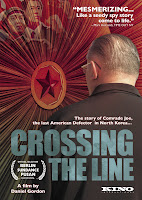 Crossing the Line
Crossing the LineProduced and directed by Daniel Gordon
Kino
The line James Joseph Dresnok crossed was the Demilitarized Zone—the border between North and South Korea, roughly corresponding to the 38th Parallel. The former Private First Class became a deserter and a traitor to his country, when he became one of four American servicemen to defect to the Northern regime. Of the four, just two survive today, and only Dresnok remains a loyal subject of Kim Jong-il. British filmmaker Daniel Gordon turns his lens on Dresnok in his documentary: Crossing the Line.
Gordon has had good fortune obtaining filming permission in the DPRK, which leads one to be a bit skeptical the film’s perspective. Although Gordon largely declines to challenge the assertions of Dresnok and a few of his Communist colleagues, his footage certainly captures how scary North Korea looks. Pyongyang appears severely Stalinist, with its personality cult monuments designed to overwhelm the individual.
Some of the strongest material of Crossing describes service along the DMZ, suggesting a great documentary could be made about those ever-present stresses and skirmishes along the border. One DMZ veteran explains:
“We were being attacked at night by North Koreans throwing hand grenades at us, and so forth. The foliage in the DMZ made it very difficult because the bad guys could come within grenade range and you didn’t know they were there, until the grenade went off.”
Gordon seems to take a similar strategy Barbet Schroeder employed in Terror’s Advocate, simply letting their subjects talk unchallenged, hoping to let them damn themselves with their own words. In each case, their success is mixed. Dresnok comes across rather churlish, carrying a chip on his shoulder for having been orphaned at an early age. He often sounds like someone who thinks the world owed him a living and found the North Koreans were willing to pay. When he lit out for the North, Dresnok knew he faced a certain court martial for forging a leave pass. When speaking of his decision to desert, Dresnok says:
“Hey, there’s the orphan, the poor boy. You ain’t shit. What am I? Am I a slave? To Hell with this.”
Dresnok and his fellow traitors became stars of North Korean propaganda pictures. He seems to have no problem parroting the party line, blaming America and Japan for the extreme famine of the 1990’s. The only issue Gordon really challenges Dresnok on is the women North Korea is widely believed to have kidnapped to become wives for the American deserters.
The case of his colleague Charles Jenkins is relatively well known. It is now well established Jenkins’s wife Hitomi Soga was kidnapped from her Japanese home on Sado Island to instruct North Korean spies. Through Japanese diplomatic initiatives Soga was returned home and Jenkins was eventually able to join her after serving a short sentence in America. Voice-over by Christian Slater explains:
“During the course of filming this project, allegations came to the fore that all the Americans were married to women who had been brought to North Korea against their will and that Dresnok’s first wife in North Korea was a Romanian kidnapped from Italy. Dresnok was reluctant to discus his first wife in North Korea. He refused to confirm where she was from and never volunteered a photograph of her.”
In addition to confirming kidnapping allegations, Jenkins has also accused Dresnok of acting as the regime’s enforcer, meting out physical punishment against him on their orders. While Dresnok gives his side of the story in Crossing, Jenkins has probably reached a wider audience on 60 Minutes. (His memoir previously published in only Japan is forthcoming from the University Press of California.)
Through
 out Crossing, Gordon seems reluctant to burn his North Korean bridges, often simply allowing Dresnok to act as a mouthpiece for his masters. However, the reality of North Korea is difficult to camouflage and Dresnok’s own failings make it near impossible to find sympathy for the treasonous deserter. It also casts needed light on the North Korean spy breeding program. It should be seen by sophisticated viewers, provided they are able to parse through Dresnok’s propaganda.
out Crossing, Gordon seems reluctant to burn his North Korean bridges, often simply allowing Dresnok to act as a mouthpiece for his masters. However, the reality of North Korea is difficult to camouflage and Dresnok’s own failings make it near impossible to find sympathy for the treasonous deserter. It also casts needed light on the North Korean spy breeding program. It should be seen by sophisticated viewers, provided they are able to parse through Dresnok’s propaganda.